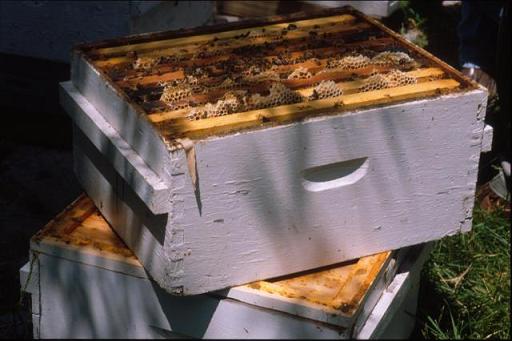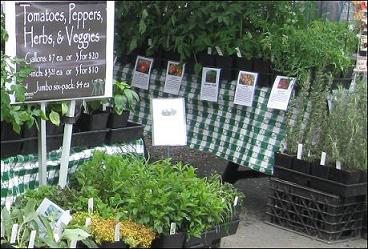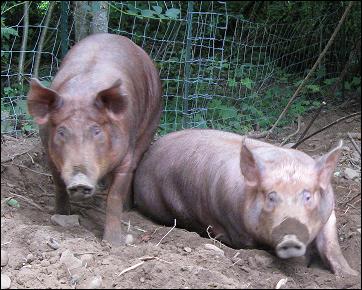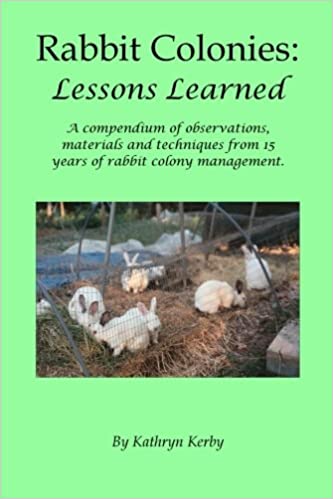CCD Strikes the Farm
June 10, 2011

As many beekeepers have reported over the last few years, one of our strong hives suddenly seemed to take a nosedive this spring. First, we saw fewer bees flying on warm days, in comparison to the other hive. Secondly, an examination of the comb found less and less new brood and general housecleaning activities, yet there were plenty of honey stores. Then the bee population began to crash. There were no fresh bodies at the bottom of the hive to indicate massive deaths in the colony, no signs of diseased brood or parasitic infestation. Individual workers apparently seemed to die in the field, leaving fewer and fewer young bees in the hive. And finally, the queen disappeared with what remained of her colony. One day, the hive was simply empty.
Swarming behavior is at its peak this time of year, but a colony normally goes through a number of steps before swarming. First, the colony is generally at robust population levels; in fact, overcrowding can be a major contributing factor to a colony’s swarming behavior. Our hive was definitely not overcrowded. Second, the workers begin preparing queen cells and/or supersedure cells. Queen larvae are fed differently, and require more cell length, than worker or drone larvae. The presence of these peanut-shell-shaped queen cells at the bottom of the hive are a dead giveaway that the colony is preparing to swarm, and beekeepers must make preparations to split the hive, add more supers, capture the swarm, or wish them a merry journey and a happy ending. On the other hand, the presence of supersedure cells is generally indicative that the existing queen is failing, and the workers are expecting her death in the near future. So they prepare one or more cells in which to raise her replacement. I would have expected that if our queen was failing, we would have seen those supersedure cells. If the colony was preparing to swarm, we definitely should have seen queen cells at the bottom. There were neither. The colony made no preparations to go. They just left. The diagnosis became more and more clear - and more troubling. I believe this was our first case of colony collapse disorder (CCD).
Researchers do not yet know why CCD occurs. There have been some good theories, and some really out-there theories, since this disorder most recently appeared in 2006. As I started to read up on CCD, I learned some interesting things:
• History has already recorded instances of mass colony failures in previous years. The 1880’s, 1920’s and 1960’s all saw dramatic declines in captive honeybee colony populations in this country. Additionally, individual regions or states have reported similar localized losses. Beekeepers in the Cache Valley of Utah lost 2000 hives after a cold, wet spring in 1903. Similarly, a group of Pennsylvania beekeepers lost over half their hives in 1995-1996 without any known causative factor.
• Human beings tend to look for a “magic bullet”, where some single, easily identifiable source caused any given problem. Eliminate that source, and we’ve eliminated the problem. In this context, many folks suspect a wide variety of individual issues would cause CCD. Amongst them are cell phones or cell phone towers, pesticides, EMT fields from power lines, microwave ovens, plastics in the hive bodies (a very common occurrence as a base for comb foundation and framing), or even some new disease or pest that weakens the bees. Unfortunately, all those possibilities have been looked into and none of them provide a crystal-clear “yes, this is the cause” answer. More commonly, a variety of these issues are present around honeybee hives, some of which thrive and some of which fail. So far there has been no magic bullet to explain CCD.
• Many researchers have turned away from searching for a single causative factor, and now are looking at “sum total” explanations for CCD. In other words, they are searching for “perfect storm” ingredients which separately would not cause CCD but which were together immediately before a CCD event. So far, the most likely perfect storm ingredients seem to be the following three:
o Long term exposure to pesticides in or near the hive,
o Disease factors which stress or weaken the hive over time, and
o Climate conditions which weaken or challenge the hive, such as prolonged cold wet weather
The more I read about CCD, the more frustrating it was. Yes we try to avoid pesticide exposure for our bees. We certainly don’t use pesticides here on the farm, but there’s no way to prevent our bees from flying offsite and being exposed on nearby properties. We do monitor our hives for disease and we hadn’t seen any, but some viral diseases can’t be detected by the naked eye. And we hadn’t had any supersedure cells constructed to indicate a failing queen. We definitely had the cold wet spring, but normally the presence of honey stores within the hive body indicate the bees are doing OK and don’t need supplemental feed. Our failed hive had plenty of honey to get them through the cool spring. Yet they left anyway.
It wasn’t until I spoke with a fellow beekeeper about my frustrations that I started to get some answers. She asked me two very specific questions which shed some welcome light on the situation:
1) Were any of my comb frames three years old, or older?
2) Were there signs of older bee die-offs from the previous winter? More than would be expected?
The answer to both questions was yes. She then explained her own theory about CCD: as the frame combs age, countless generations of honeybees are raised and hatched out within those cells. Similarly, countless waves of honey production will occur as a cell is filled with nectar, capped, eaten then refilled. Each new wave of cell growth, or honey production, introduces a small amount of new contamination and disease vectors. It has been her experience that after about three years, comb foundations has simply become too contaminated, and should be retired and replaced with new frames. If that comb is not replaced, the bees reach a point where they simply refuse to live there anymore. If they have other areas of the hive to retreat to, they move there. If there’s no where else within that hive super to go, they leave even if they don’t have the standard buildup of pre-swarm population to do so. Like a human family abandoning a home which is no longer fit to live in, the bees simply abandon a hive that is no longer clean enough for them to live in.
Her explanation made a lot of sense to me. My hive had consisted of two older supers over the winter, and I had put two new shallow supers on top earlier this year. Of the two older supers, one of them was four years old and one of them was three years old. After my conversation with her, I checked the hive again. The oldest honeycomb had clearly been abandoned a long time ago, with no signs of recent use as either brood rearing or honeycomb. But the bees had to go through that section of hive to get outside. The next-oldest honeycomb was where the honey was being stored and eggs being laid. The bees had not finished prepping the newest shallow supers, and even if they had, queens don’t like laying eggs in shallow supers. So honey is usually stored there instead. I had deliberately used shallow supers for that very reason. In short, my honeybee colony’s home had an old, worn, dirty living room and entranceway, an only slightly better kitchen and bedroom area, and the new addition wasn’t big enough for the kids. No wonder they left.
But what had not yet occurred to me, was that the queen and the remainder of her colony were still out there, somewhere. Most CCD reading equates an empty hive with a dead colony. What my experience seemed to indicate, and what my beekeeper friend seemed to believe, is that they weren’t dead, but rather they had simply moved elsewhere. Which means that there are possibly a great deal of honeybee colonies which have left domestic production and taken up residence in nearby areas - abandoned logs, brush, dead tree snags, even the rafters of buildings. While doing my research, I looked for studies about the population growth or decline of wild honeybee colonies over time. Unfortunately, many articles which were supposedly about “wild” colony populations blurred the distinction between domesticated and feral populations. Or, the population estimates were based on swarm numbers, which again did not differentiate between domestic and feral populations, let alone whether the swarms had left due to “healthy” hive activities or due to CCD. Combine that with an overall dramatic drop in hobbyist beekeepers in most areas over the last few decades. It was therefore very difficult to tease out information about whether wild populations had actually declined. There did seem to be a decline in all honeybee populations - captive and wild - in industrial areas. Yet at least one study found populations were much higher in remote, supposedly more harsh locations.
I think there are several “take-away” lessons to be learned here. First, I need to do a better job of monitoring and maintaining our hives - I should have replaced the old comb, and treated the hive with some immune boosters as soon as I saw higher-than-average losses over the winter. Second, I should make arrangements to bring the colonies into a protected area each winter so they aren’t quite so stressed by cold temps and high humidity. Third, I should supplement the hive anytime we have cold, wet spring conditions like we did this year. Even if they have honey stores, I should give them the option to choose another food source. I can also supplement them with pollen supplies (although there are issues with that, which I’ll detail in a future blog).
Sadly, though, I think that many elements of that perfect storm are beyond my immediate control. Widespread pesticide use will probably continue as long as it’s cheaper to spray than to control insects in other ways, and as long as humanity is more interested in quick solutions than long-term sustainability. I dearly wish I knew how to change that “instant gratification trumps long term health” problem. Secondly, the loss of wild ecosystems, which once served as safe havens for swarms (along with a lot of other beneficial life) is occurring at a dizzying pace. Sterile parkland cannot replace well-diversified, productive wild areas. We strive to keep part of our farm wild for exactly that purpose, but many other areas continue their wholesale land clearing activities without regard for creating such reservoirs. Ultimately at some point we need to figure out, like the bees already have, that we can’t live in a contaminated home for very long without getting really uncomfortable. Unlike the bees, we have nowhere else to fly off to if our little world becomes too contaminated. Nature’s wisdom is perhaps yelling in our ear right now to wake up and pay attention.
Pricing Our Farm Products
June 6, 2011

You would think that pricing at market is very straightforward, consisting of three basic elements:
• figure out how much it costs to produce something,
• figure out what sort of profit margin you want (or need to make) to justify that product versus raising and selling something else
• figure out what price range the market will bear, then set your price within that range
Alas, if only it were that simple.
I am by no means an expert in sales, having only started operating the farm as a business in recent years, and only selling at farmers’ markets in the last two years. Nevertheless, there are some lessons to be learned about how to price for-sale items, or ironically, how NOT to price them, which bear consideration for anyone thinking about selling farm produce or products. And no, unfortunately it’s not straightforward.
Let’s start with the basics. The first item in the above list is absolutely required. Whatever you end up setting as your price, you must first start with knowledge about how much it costs to produce. And that by itself can get a little tricky. I wrote several months ago about all the variables that go into pricing something as straightforward as a dozen chicken eggs. You can read that blog entry here. Most producers, me included, will look at the biggest costs per product, figure out a ballpark “per item” cost, and not sweat those smaller variables which add only a few extra pennies of cost per item. While not a perfect analysis, it gives us a very good approximate idea of the major costs, without requiring quite so much analytical effort.
But what about the next item on the list, determining the desired profit margin? Here’s where things start to get a little fuzzy. Many beginning producers would be thrilled to see any sort of profit at all, so they don’t get much further than merely aiming for any pricing which covers and surpasses their costs. At that margin where many producers hover between farming as a hobby and farming as a business, the notion of profit seems optional because they’ll keep farming whether they make money or not. Yet profit is the fuel which allows farms (or any business) to move forward with new projects, or provides funds for fixing, replacing, repairing or sprucing up existing infrastructure. There’s a wise phrase from a farming business book which I read years ago called A Farmer’s Guide To The Bottom Line, where author Charles Walters admonishes us to “capitalize on savings; expand with earnings”. In other words, let some other windfall get you started with your farming activities. We all have to start somewhere whether it’s inheriting a farm or earning startup money from some off-farm job. But only use that as seed money. Beyond that tiny little startup, any future expansion should ideally be paid for by money you’ve earned in that business. If more producers (or business owners of any stripe) followed that advice, we’d have a whole lot more small business success than we do. Certainly, I’ve broken that rule countless times, in large part because I didn’t know any better. Now that I do know better, I work really hard to make the farm pay its way, and pay for any expansion. The major exception to that remains the application of one-time extra funds to improve efficiency, such that we’re not bleeding money somewhere else. Even that should eventually yield to all farm inputs being paid by farm profits.
Yet even that isn’t enough. That last listed item - figuring out what the market will bear - is perhaps the most elusive of all. Everything up until this moment has fundamentally been under our control - our costs, our start-up plans, our expansion plans, and our profit goals. But when we start to look at what the market will bear, then we get into negotiations with other folks where a whole fleet of additional criteria come into play. Is our product available elsewhere at lower cost, higher quality, or with better customer service? Another “rule” in the pricing game is that a buyer will determine where to shop based on three criteria: pricing, quality and service, and that the seller offering the best two of those three factors will win the sale. In other words, if you can’t offer low pricing, you’d better be able to offer higher quality and better service. If you can’t offer good service, you need to provide lower pricing and better quality, etc. Another issue is whether you have something that no one else has. If you’re the only game in town, folks will sometimes (but not always) buy from you even if you have high prices, low quality and terrible service. However, as soon as you have competition, the “best two out of three” rule will go back into effect. So a producer needs to know not only what their costs and profit margin goals are, but also what “the other guy” is selling, and for how much. If you can do better, you’ll win sales. There is your challenge and opportunity.
And here is where small producers often get very frustrated, but ironically this is where they have the best advantage. We already know we can’t compete with major industrial agriculture which can churn out veggies and meats at a fraction of our per-item costs. Some producers figure they have no other option but to engage in what is called “a race to the bottom”, where they try to cut either their costs and/or their profit margin, such that they can compete with those large-scale producers. Most small farm analysts agree that such a race is doomed, and will only result in the failure of yet more small family farms. We simply don’t have efficiency of scale on our side. Hence the recommendation to “get big or get out”. Sadly, that advice also spelled the end of many farms in the last 50 years as they expanded beyond their capabilities. Instead, many small farm advocates are encouraging producers to enter and compete in those markets where they can work on those other two factors - quality and customer service. If you can offer higher quality AND better customer service for your veggies, your meats, your dairy, whatever, you will win some buyers away from those who offer cut-rate pricing. Not all of them, but some of them.
Farmers markets and CSAs, direct sales to restaurants, even local sales to schools, hospitals and other institutions are ever-changing efforts. And producers have as much work post-harvest as they do pre-harvest, in terms of finding, securing and managing their product outlets. With some thoughtful analysis, any given producer can make wise choices about how best to price their various products. While that analysis may indicate a favorite market isn’t performing well anymore, it can also highlight new markets which look likely to perform better. Without that analysis, producers are essentially taking pot shots in the dark and hoping to hit something on a regular basis. It’s worth some effort to make sure we hit that target as often as possible.
Breeding Pigs with Artificial Insemination
June 2, 2011

This past winter, I wrote about using Artificial Insemination (AI) as a preferred method for breeding pigs. AI has several advantages over working with live boars - easier than transporting either the sow or boar, less disease risk, easier for the handler, and more bloodline choices. So we looked forward to AI’ing our two young gilts in March.
Of course, life in general and farming in particular rarely ever go strictly according to plan. Such was the case this spring for us. When I wrote that blog entry, we knew that both our gilts were due to come back into season in early March, and then again in late March, either of which were good breeding dates for us. Yet in late February, we had a series of moderate-to-serious family emergencies which completely upended our schedule here. Dealing with those became the priority, such that only the most fundamental and/or crucial tasks on the farm were dealt with. One of the tasks which went unaddressed was the pig breeding. We didn’t even see them go into estrus during a nearly two month period. Therefore, not only did we not get them bred, we didn’t write down their cycle dates. We had to wait until they cycled sometime in April, then start the countdown over again. April came and went, and we were able to document their cycles and get back on track with our breeding plans. They were both due to cycle again in the third week of May. On May 16th, we bought in our AI supplies, enough for both gilts, such that we’d be ready a few days early. And then we waited.
Swine AI has one downside. Unlike AI for other species, boar semen is not typically frozen and withdrawn from a storage tank as needed. It is shipped fresh instead. Even when using a semen extender, it has a relatively short effectiveness period of only 4-7 days. And a sow’s peak fertility period only lasts approximately 24 hours, sometimes only 18 hours for gilts. So there’s a relatively small window of opportunity to get in the supplies, and use them, before either the gilt or the semen loses fertility. If a gilt or sow doesn’t cycle as expected, all bets are off.
I don’t know if it was the cold wet spring or I did the math wrong, but both our gilts’ cycles were a few days later than expected. That first batch of AI semen reached the end of its best-use-by date, and neither gilt had shown any signs of estrus yet. Sigh. As the saying goes, “you pays your money and you takes your chances.” In this instance, I had spent about $200 buying in the semen and insemination tubes that I needed. Of course the tubes would last indefinitely. However, the semen would not. On the 7th day after the semen had been collected, at the very end of its storage life, one gilt finally showed the first signs of estrus. Since there is a 24-48 hour period between those first signs and her period of peak fertility, I knew I had to order in more semen, pronto. So I got on the phone and ordered in more semen to be shipped overnight, at the cost of another $150. Happily, that gilt’s estrus developed normally, and my second round of AI supplies arrived that next day. I was able to give her two good AI sessions roughly 18 and 24 hours after the start of standing heat, which were both within range of her most fertile period. During her third and final AI session, she wouldn’t cooperate, which probably meant she was going out of standing heat. I had hit my first gitl’s AI scheduling right on target, despite the initial delay. One gilt down, one to go.
When I had tracked my gilts’ cycles earlier in the year, I knew that the second gilt would typically cycle five days after the first. When I ordered in that second batch of AI supplies, I knew that even if I hit the first gilt’s target dates, I would still be at the end of the use-by date for the semen by the time that second gilt came into standing heat. So it was no big surprise that the second batch of semen’s best-use-by date came and went before the second sow came into estrus. I had already blown my budget for what I’d wanted to spend on getting them bred, but I either had to hit this next estrus, or wait almost another month. I made the call, and ordered in more. The supplies arrived that next morning, and still no estrus. That next day, still no estrus. I started to wonder if perhaps I had missed her cycle altogether, in which case I’d just blown another $150. I was not pleased.
Then I remembered something I’d learned a long time previously. Sometimes a dominant animal of either sex will be so confident of their rank, that they will freely display estrus or rut without concerns about simultaneously defending their social position in the herd. However, when animals are closely matched in rank, sometimes the effort required to defend that social position can result in less overt displays of estrus or rut. It’s almost as if the animal is too “busy” maintaining that social ranking, to be bothered with sex. In those cases, sometimes teasing by the opposite sex is helpful, or even required, to bring about the hormones required for reproductive behavior. To be blunt, some foreplay is required. My pig mentor had also once told me that some sows seemed to need the scratching and playful shoving they’d receive from the boar, before they will stand for AI breeding. That seemed to correlate with the occasional need for foreplay. My two gilts were littermates, and the gilt I was waiting on was the more dominant of the two. But they sparred constantly, jostling with each other for dominance. I wondered if perhaps this gilt wasn’t showing her estrus because she was trying to hang onto her currently slim lead over her sister. So I tried something different with her. Two days ago, when that gilt should have been in a good solid standing heat, I launched Operation Flirt-with-the-Pig. I fed them dinner early that evening. About an hour after feeding, when both gilts were full and content and settling down for the night (thus, very little sparring behavior), I went back outside, specifically to work with the reluctant gilt. Boars will chant to their ladies, and rub their heads and snouts along the female’s side, and scratch the ladies’ sides with their trotters while they attempt to mount. So I duplicated these behaviors as best I could, having neither snout nor trotters. I spoke softly to the gilt in a low monotone, telling her how gorgeous she was, and I gave her good long back scratches, which I already knew she generally liked even when not in estrus. I spent about 15 minutes doing that, then went back into the house and waited an hour. Then right at sunset, I took my AI supplies back down to the pig yard, with my fingers crossed. And voila! That gilt was finally showing a good solid standing estrus. I was able to service her right then, then again early the next morning, and then again around 11am. By dinnertime that next evening, 24 hours after I’d first flirted with her, she was moving out of standing heat. It looked like I had hit my AI window of opportunity with her as well. And now we wait to see if they come back into standing heat. If they don’t cycle again, we succeeded with our AI efforts.
For those readers who are interested in pursuing AI for their own swine, there are a lot of good resources online for how to predict gilt and sow fertility, and how to do AI. I used the following websites and videos to learn this method:
Univ of Pennsylvania Swine Reproduction Information
English-language article about using AI on small swine farms in France
Youtube video about Louisiana State University Swine Breeding Program
University class demonstration on swine AI
Prairie State Semen Supply
Swine Genetics International
Our Successful Farming and Ranching Books

We released our very first self-published book. The Chicken Coop Manual in 2014. It is a full color guide to conventional and alternative poultry housing options, including 8 conventional stud construction plans, 12 alternative housing methods, and almost 20 different design features. This book is available on Amazon.com and as a PDF download. Please visit The Chicken Coop Manual page for more information.

Rabbit Colonies: Lessons Learned
We started with rabbits in 2002, and we've been experimenting with colony management ever since. Fast forward to 2017, when I decided to write another book, this time about colony management. The book is chock-full of practical information, and is available from both Amazon and as a PDF download. Please visit the Rabbit Colonies page for more information.
The Pastured Pig Handbook
We are currently working on our next self-published book: The Pastured Pig Handbook. This particular book addresses a profitable, popular and successful hog management approach which sadly is not yet well documented. Our handbook, will cover all the various issues involved with pastured hog management, including case studies of numerous current pastured pig operations. If you have any questions about this book, please Contact Us.

Weblog Archives
We published a farm blog between January 2011 and April 2012. We reluctantly ceased writing them due to time constraints, and we hope to begin writing them again someday. In the meantime, we offer a Weblog Archive so that readers can access past blog articles at any time.
If and when we return to writing blogs, we'll post that news here. Until then, happy reading!




